Analysing Text
VerifiedAdded on 2023/06/13
|9
|3009
|141
AI Summary
This essay discusses the grammatical, morphological and lexeme errors made in the given text. It analyses the pattern of writing, sentence structures, tense, voice, vocabulary and punctuation errors.
Contribute Materials
Your contribution can guide someone’s learning journey. Share your
documents today.

Running head: ANALYSING TEXT
ANALYSING TEXT
Name of the student:
Name of University:
Author Note:
ANALYSING TEXT
Name of the student:
Name of University:
Author Note:
Secure Best Marks with AI Grader
Need help grading? Try our AI Grader for instant feedback on your assignments.

1ANALYSING TEXT
This essay has discussed the grammatical, morphological and lexeme errors made in
the given text. Here the writer has used ample of exaggerative words which do not really
have any implication in the meaning of the sentence. The pattern of writing is quite satisfying
because the writer has introduced different information for this particular argument.
However, in this text there has been a lot of mistake in the sentence structures. There are
some morphological mistakes where the writer has not used proper form of a lexeme with
proper prefix or suffix. In most of the cases the writer has used compound sentence with
different types of linkers but not all of those conjunctions have appropriateness in their usage.
Present tense is the most observed tense in this text but the writer has used incorrect voice
often. The use of words by the writer captures his weak vocabulary hence he has used same
words a twice in one sentence.
From the beginning of the paragraph the writer has used present tense. The entire
piece is dominated by the excessive use of present tense which is often incorrect (Rochemont,
2014). In the first line, the writer has talked about nuclear power which is in singular form.
The word nuclear power is a proper noun but at the end the writer has made use of common
noun ‘sources’ which needed to be in singular. On the other hand, if the writer wanted to
demonstrate that the nuclear power is an example of cheap energy source, he must have used
different verb instead of ‘provides’ because this particular verb does not have any connection
with amplification of a noun.
In the second line, the use of word, ‘sometimes’ is inappropriate as it is not matching
the real phenomena of energy misbalance on the earth. Instead of sometimes, the writer may
have used ‘in the near future; or ‘one day’ to denote the intensity of the situation. The
vocabulary of the writer seems to be poor or he does not have much knowledge about the
difference between the natural components of energy or the sources of energy. This writer
has termed oil and gas to be the sources of energy but these actually are components of
This essay has discussed the grammatical, morphological and lexeme errors made in
the given text. Here the writer has used ample of exaggerative words which do not really
have any implication in the meaning of the sentence. The pattern of writing is quite satisfying
because the writer has introduced different information for this particular argument.
However, in this text there has been a lot of mistake in the sentence structures. There are
some morphological mistakes where the writer has not used proper form of a lexeme with
proper prefix or suffix. In most of the cases the writer has used compound sentence with
different types of linkers but not all of those conjunctions have appropriateness in their usage.
Present tense is the most observed tense in this text but the writer has used incorrect voice
often. The use of words by the writer captures his weak vocabulary hence he has used same
words a twice in one sentence.
From the beginning of the paragraph the writer has used present tense. The entire
piece is dominated by the excessive use of present tense which is often incorrect (Rochemont,
2014). In the first line, the writer has talked about nuclear power which is in singular form.
The word nuclear power is a proper noun but at the end the writer has made use of common
noun ‘sources’ which needed to be in singular. On the other hand, if the writer wanted to
demonstrate that the nuclear power is an example of cheap energy source, he must have used
different verb instead of ‘provides’ because this particular verb does not have any connection
with amplification of a noun.
In the second line, the use of word, ‘sometimes’ is inappropriate as it is not matching
the real phenomena of energy misbalance on the earth. Instead of sometimes, the writer may
have used ‘in the near future; or ‘one day’ to denote the intensity of the situation. The
vocabulary of the writer seems to be poor or he does not have much knowledge about the
difference between the natural components of energy or the sources of energy. This writer
has termed oil and gas to be the sources of energy but these actually are components of
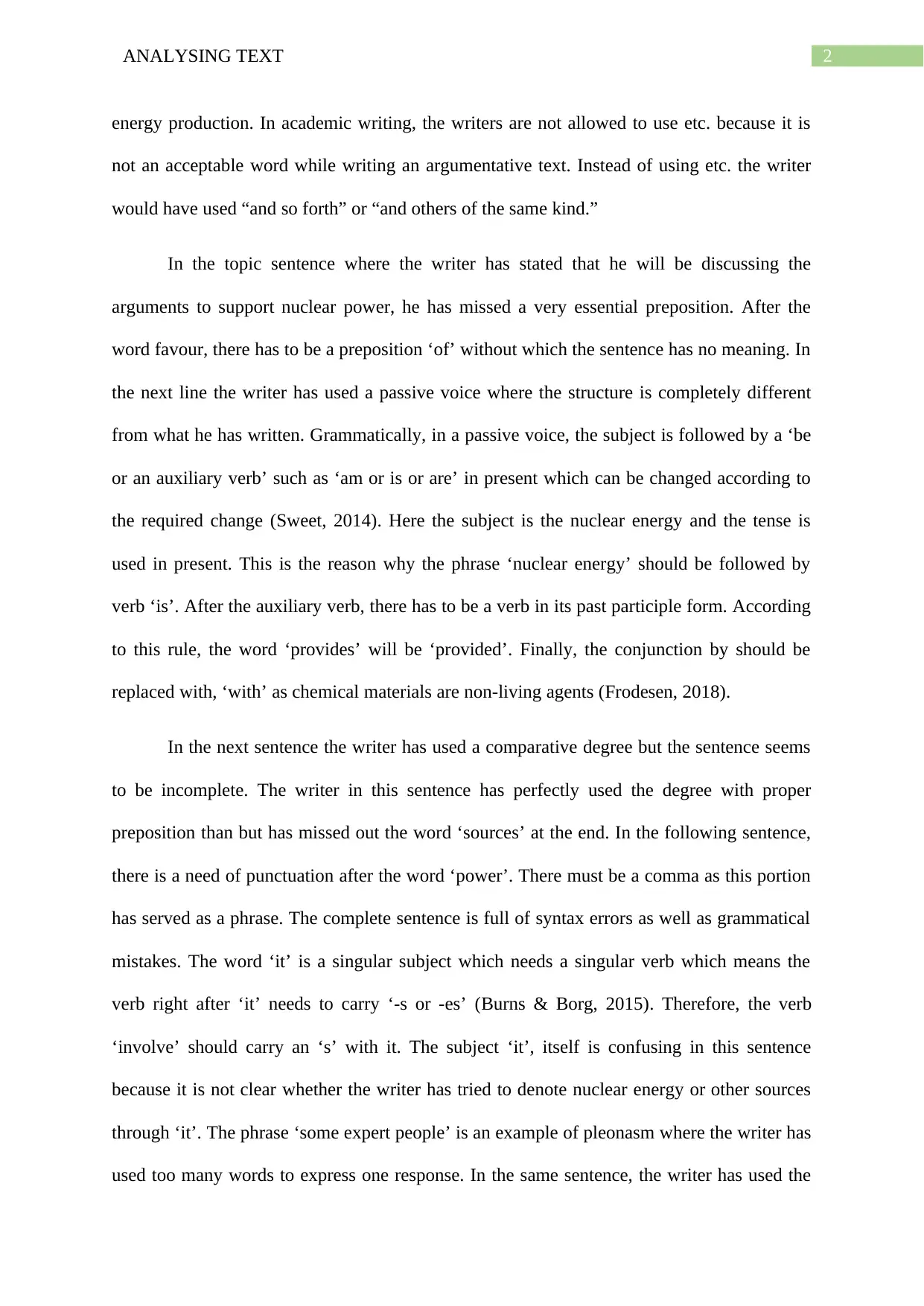
2ANALYSING TEXT
energy production. In academic writing, the writers are not allowed to use etc. because it is
not an acceptable word while writing an argumentative text. Instead of using etc. the writer
would have used “and so forth” or “and others of the same kind.”
In the topic sentence where the writer has stated that he will be discussing the
arguments to support nuclear power, he has missed a very essential preposition. After the
word favour, there has to be a preposition ‘of’ without which the sentence has no meaning. In
the next line the writer has used a passive voice where the structure is completely different
from what he has written. Grammatically, in a passive voice, the subject is followed by a ‘be
or an auxiliary verb’ such as ‘am or is or are’ in present which can be changed according to
the required change (Sweet, 2014). Here the subject is the nuclear energy and the tense is
used in present. This is the reason why the phrase ‘nuclear energy’ should be followed by
verb ‘is’. After the auxiliary verb, there has to be a verb in its past participle form. According
to this rule, the word ‘provides’ will be ‘provided’. Finally, the conjunction by should be
replaced with, ‘with’ as chemical materials are non-living agents (Frodesen, 2018).
In the next sentence the writer has used a comparative degree but the sentence seems
to be incomplete. The writer in this sentence has perfectly used the degree with proper
preposition than but has missed out the word ‘sources’ at the end. In the following sentence,
there is a need of punctuation after the word ‘power’. There must be a comma as this portion
has served as a phrase. The complete sentence is full of syntax errors as well as grammatical
mistakes. The word ‘it’ is a singular subject which needs a singular verb which means the
verb right after ‘it’ needs to carry ‘-s or -es’ (Burns & Borg, 2015). Therefore, the verb
‘involve’ should carry an ‘s’ with it. The subject ‘it’, itself is confusing in this sentence
because it is not clear whether the writer has tried to denote nuclear energy or other sources
through ‘it’. The phrase ‘some expert people’ is an example of pleonasm where the writer has
used too many words to express one response. In the same sentence, the writer has used the
energy production. In academic writing, the writers are not allowed to use etc. because it is
not an acceptable word while writing an argumentative text. Instead of using etc. the writer
would have used “and so forth” or “and others of the same kind.”
In the topic sentence where the writer has stated that he will be discussing the
arguments to support nuclear power, he has missed a very essential preposition. After the
word favour, there has to be a preposition ‘of’ without which the sentence has no meaning. In
the next line the writer has used a passive voice where the structure is completely different
from what he has written. Grammatically, in a passive voice, the subject is followed by a ‘be
or an auxiliary verb’ such as ‘am or is or are’ in present which can be changed according to
the required change (Sweet, 2014). Here the subject is the nuclear energy and the tense is
used in present. This is the reason why the phrase ‘nuclear energy’ should be followed by
verb ‘is’. After the auxiliary verb, there has to be a verb in its past participle form. According
to this rule, the word ‘provides’ will be ‘provided’. Finally, the conjunction by should be
replaced with, ‘with’ as chemical materials are non-living agents (Frodesen, 2018).
In the next sentence the writer has used a comparative degree but the sentence seems
to be incomplete. The writer in this sentence has perfectly used the degree with proper
preposition than but has missed out the word ‘sources’ at the end. In the following sentence,
there is a need of punctuation after the word ‘power’. There must be a comma as this portion
has served as a phrase. The complete sentence is full of syntax errors as well as grammatical
mistakes. The word ‘it’ is a singular subject which needs a singular verb which means the
verb right after ‘it’ needs to carry ‘-s or -es’ (Burns & Borg, 2015). Therefore, the verb
‘involve’ should carry an ‘s’ with it. The subject ‘it’, itself is confusing in this sentence
because it is not clear whether the writer has tried to denote nuclear energy or other sources
through ‘it’. The phrase ‘some expert people’ is an example of pleonasm where the writer has
used too many words to express one response. In the same sentence, the writer has used the
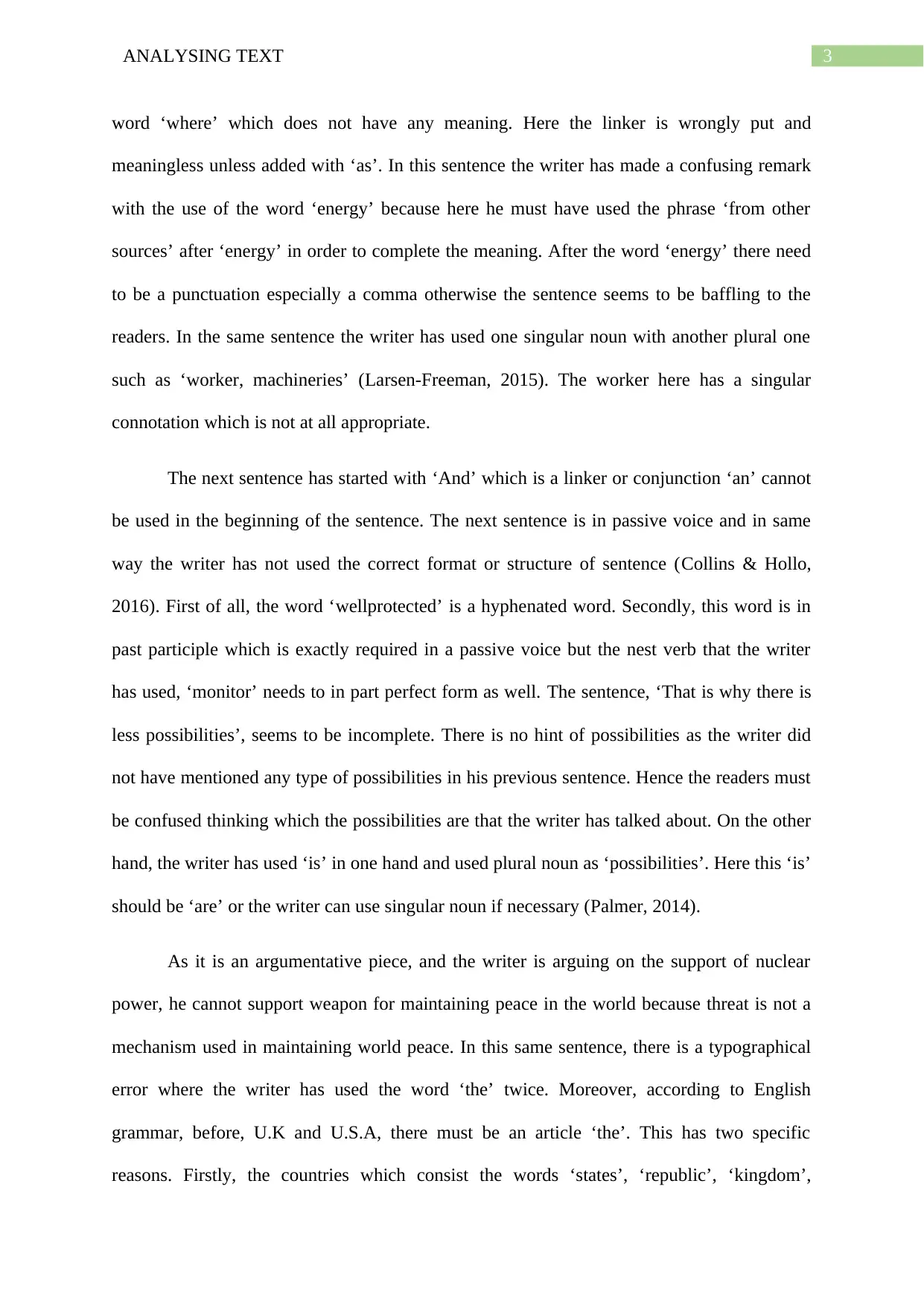
3ANALYSING TEXT
word ‘where’ which does not have any meaning. Here the linker is wrongly put and
meaningless unless added with ‘as’. In this sentence the writer has made a confusing remark
with the use of the word ‘energy’ because here he must have used the phrase ‘from other
sources’ after ‘energy’ in order to complete the meaning. After the word ‘energy’ there need
to be a punctuation especially a comma otherwise the sentence seems to be baffling to the
readers. In the same sentence the writer has used one singular noun with another plural one
such as ‘worker, machineries’ (Larsen-Freeman, 2015). The worker here has a singular
connotation which is not at all appropriate.
The next sentence has started with ‘And’ which is a linker or conjunction ‘an’ cannot
be used in the beginning of the sentence. The next sentence is in passive voice and in same
way the writer has not used the correct format or structure of sentence (Collins & Hollo,
2016). First of all, the word ‘wellprotected’ is a hyphenated word. Secondly, this word is in
past participle which is exactly required in a passive voice but the nest verb that the writer
has used, ‘monitor’ needs to in part perfect form as well. The sentence, ‘That is why there is
less possibilities’, seems to be incomplete. There is no hint of possibilities as the writer did
not have mentioned any type of possibilities in his previous sentence. Hence the readers must
be confused thinking which the possibilities are that the writer has talked about. On the other
hand, the writer has used ‘is’ in one hand and used plural noun as ‘possibilities’. Here this ‘is’
should be ‘are’ or the writer can use singular noun if necessary (Palmer, 2014).
As it is an argumentative piece, and the writer is arguing on the support of nuclear
power, he cannot support weapon for maintaining peace in the world because threat is not a
mechanism used in maintaining world peace. In this same sentence, there is a typographical
error where the writer has used the word ‘the’ twice. Moreover, according to English
grammar, before, U.K and U.S.A, there must be an article ‘the’. This has two specific
reasons. Firstly, the countries which consist the words ‘states’, ‘republic’, ‘kingdom’,
word ‘where’ which does not have any meaning. Here the linker is wrongly put and
meaningless unless added with ‘as’. In this sentence the writer has made a confusing remark
with the use of the word ‘energy’ because here he must have used the phrase ‘from other
sources’ after ‘energy’ in order to complete the meaning. After the word ‘energy’ there need
to be a punctuation especially a comma otherwise the sentence seems to be baffling to the
readers. In the same sentence the writer has used one singular noun with another plural one
such as ‘worker, machineries’ (Larsen-Freeman, 2015). The worker here has a singular
connotation which is not at all appropriate.
The next sentence has started with ‘And’ which is a linker or conjunction ‘an’ cannot
be used in the beginning of the sentence. The next sentence is in passive voice and in same
way the writer has not used the correct format or structure of sentence (Collins & Hollo,
2016). First of all, the word ‘wellprotected’ is a hyphenated word. Secondly, this word is in
past participle which is exactly required in a passive voice but the nest verb that the writer
has used, ‘monitor’ needs to in part perfect form as well. The sentence, ‘That is why there is
less possibilities’, seems to be incomplete. There is no hint of possibilities as the writer did
not have mentioned any type of possibilities in his previous sentence. Hence the readers must
be confused thinking which the possibilities are that the writer has talked about. On the other
hand, the writer has used ‘is’ in one hand and used plural noun as ‘possibilities’. Here this ‘is’
should be ‘are’ or the writer can use singular noun if necessary (Palmer, 2014).
As it is an argumentative piece, and the writer is arguing on the support of nuclear
power, he cannot support weapon for maintaining peace in the world because threat is not a
mechanism used in maintaining world peace. In this same sentence, there is a typographical
error where the writer has used the word ‘the’ twice. Moreover, according to English
grammar, before, U.K and U.S.A, there must be an article ‘the’. This has two specific
reasons. Firstly, the countries which consist the words ‘states’, ‘republic’, ‘kingdom’,
Secure Best Marks with AI Grader
Need help grading? Try our AI Grader for instant feedback on your assignments.
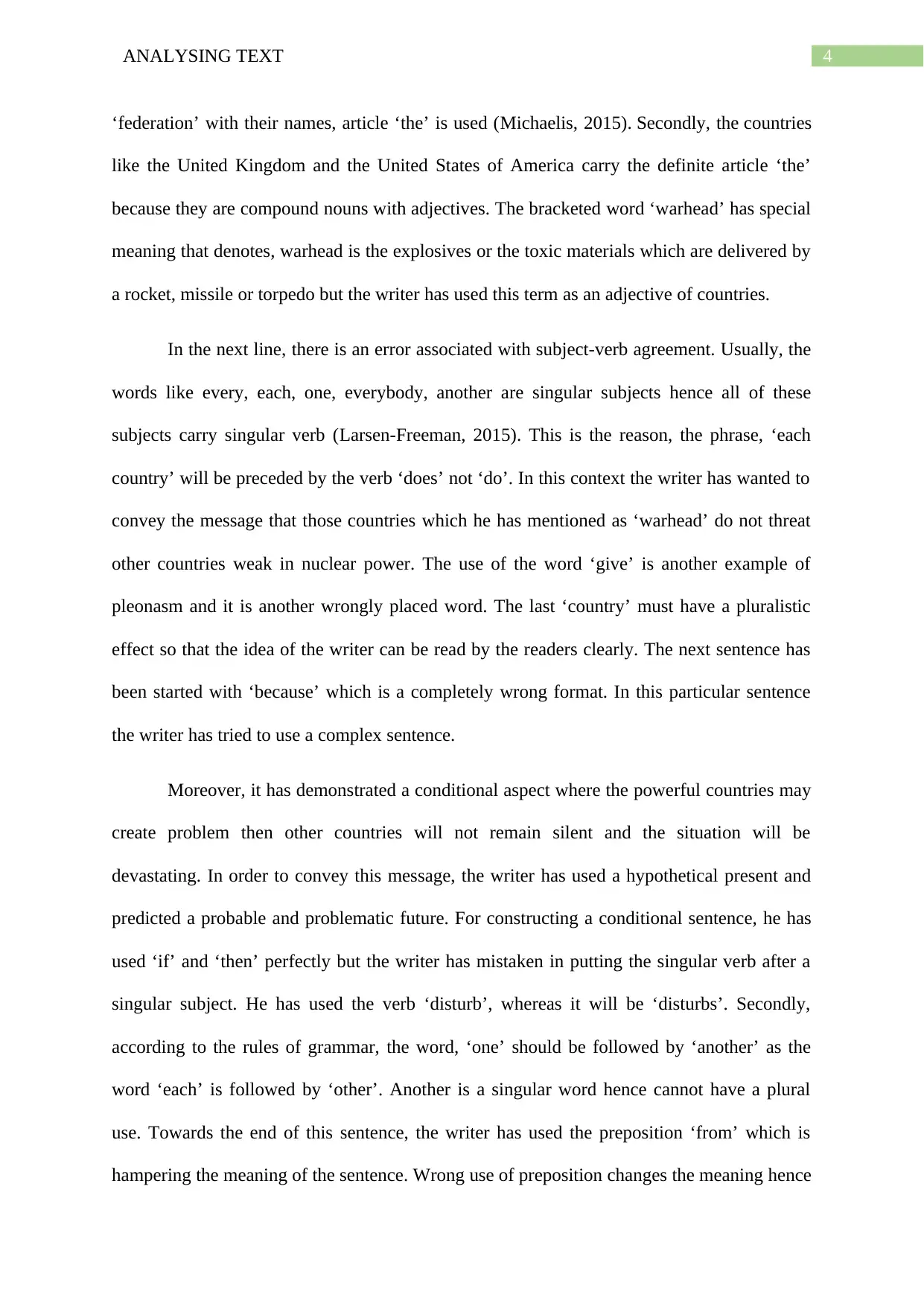
4ANALYSING TEXT
‘federation’ with their names, article ‘the’ is used (Michaelis, 2015). Secondly, the countries
like the United Kingdom and the United States of America carry the definite article ‘the’
because they are compound nouns with adjectives. The bracketed word ‘warhead’ has special
meaning that denotes, warhead is the explosives or the toxic materials which are delivered by
a rocket, missile or torpedo but the writer has used this term as an adjective of countries.
In the next line, there is an error associated with subject-verb agreement. Usually, the
words like every, each, one, everybody, another are singular subjects hence all of these
subjects carry singular verb (Larsen-Freeman, 2015). This is the reason, the phrase, ‘each
country’ will be preceded by the verb ‘does’ not ‘do’. In this context the writer has wanted to
convey the message that those countries which he has mentioned as ‘warhead’ do not threat
other countries weak in nuclear power. The use of the word ‘give’ is another example of
pleonasm and it is another wrongly placed word. The last ‘country’ must have a pluralistic
effect so that the idea of the writer can be read by the readers clearly. The next sentence has
been started with ‘because’ which is a completely wrong format. In this particular sentence
the writer has tried to use a complex sentence.
Moreover, it has demonstrated a conditional aspect where the powerful countries may
create problem then other countries will not remain silent and the situation will be
devastating. In order to convey this message, the writer has used a hypothetical present and
predicted a probable and problematic future. For constructing a conditional sentence, he has
used ‘if’ and ‘then’ perfectly but the writer has mistaken in putting the singular verb after a
singular subject. He has used the verb ‘disturb’, whereas it will be ‘disturbs’. Secondly,
according to the rules of grammar, the word, ‘one’ should be followed by ‘another’ as the
word ‘each’ is followed by ‘other’. Another is a singular word hence cannot have a plural
use. Towards the end of this sentence, the writer has used the preposition ‘from’ which is
hampering the meaning of the sentence. Wrong use of preposition changes the meaning hence
‘federation’ with their names, article ‘the’ is used (Michaelis, 2015). Secondly, the countries
like the United Kingdom and the United States of America carry the definite article ‘the’
because they are compound nouns with adjectives. The bracketed word ‘warhead’ has special
meaning that denotes, warhead is the explosives or the toxic materials which are delivered by
a rocket, missile or torpedo but the writer has used this term as an adjective of countries.
In the next line, there is an error associated with subject-verb agreement. Usually, the
words like every, each, one, everybody, another are singular subjects hence all of these
subjects carry singular verb (Larsen-Freeman, 2015). This is the reason, the phrase, ‘each
country’ will be preceded by the verb ‘does’ not ‘do’. In this context the writer has wanted to
convey the message that those countries which he has mentioned as ‘warhead’ do not threat
other countries weak in nuclear power. The use of the word ‘give’ is another example of
pleonasm and it is another wrongly placed word. The last ‘country’ must have a pluralistic
effect so that the idea of the writer can be read by the readers clearly. The next sentence has
been started with ‘because’ which is a completely wrong format. In this particular sentence
the writer has tried to use a complex sentence.
Moreover, it has demonstrated a conditional aspect where the powerful countries may
create problem then other countries will not remain silent and the situation will be
devastating. In order to convey this message, the writer has used a hypothetical present and
predicted a probable and problematic future. For constructing a conditional sentence, he has
used ‘if’ and ‘then’ perfectly but the writer has mistaken in putting the singular verb after a
singular subject. He has used the verb ‘disturb’, whereas it will be ‘disturbs’. Secondly,
according to the rules of grammar, the word, ‘one’ should be followed by ‘another’ as the
word ‘each’ is followed by ‘other’. Another is a singular word hence cannot have a plural
use. Towards the end of this sentence, the writer has used the preposition ‘from’ which is
hampering the meaning of the sentence. Wrong use of preposition changes the meaning hence
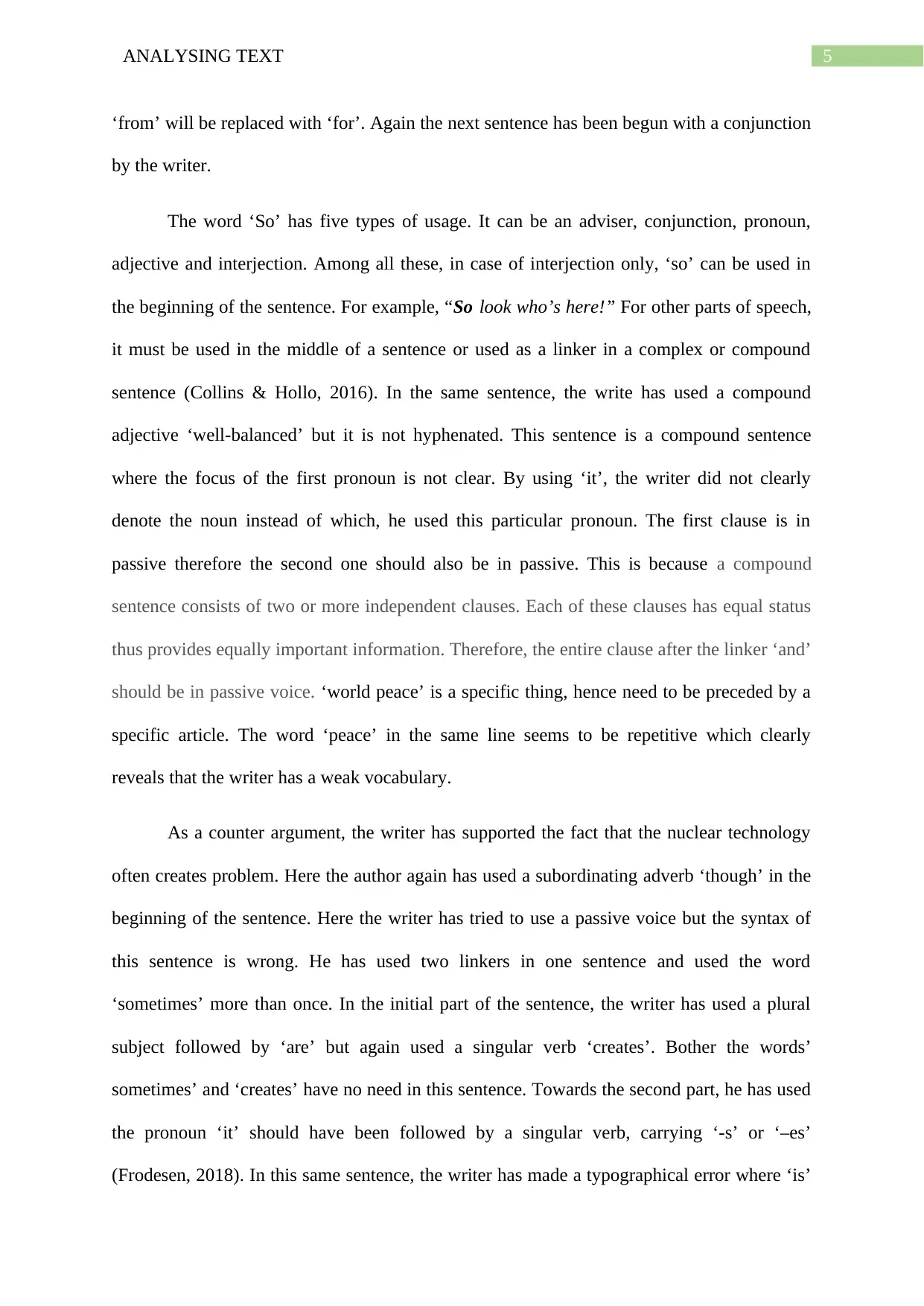
5ANALYSING TEXT
‘from’ will be replaced with ‘for’. Again the next sentence has been begun with a conjunction
by the writer.
The word ‘So’ has five types of usage. It can be an adviser, conjunction, pronoun,
adjective and interjection. Among all these, in case of interjection only, ‘so’ can be used in
the beginning of the sentence. For example, “So look who’s here!” For other parts of speech,
it must be used in the middle of a sentence or used as a linker in a complex or compound
sentence (Collins & Hollo, 2016). In the same sentence, the write has used a compound
adjective ‘well-balanced’ but it is not hyphenated. This sentence is a compound sentence
where the focus of the first pronoun is not clear. By using ‘it’, the writer did not clearly
denote the noun instead of which, he used this particular pronoun. The first clause is in
passive therefore the second one should also be in passive. This is because a compound
sentence consists of two or more independent clauses. Each of these clauses has equal status
thus provides equally important information. Therefore, the entire clause after the linker ‘and’
should be in passive voice. ‘world peace’ is a specific thing, hence need to be preceded by a
specific article. The word ‘peace’ in the same line seems to be repetitive which clearly
reveals that the writer has a weak vocabulary.
As a counter argument, the writer has supported the fact that the nuclear technology
often creates problem. Here the author again has used a subordinating adverb ‘though’ in the
beginning of the sentence. Here the writer has tried to use a passive voice but the syntax of
this sentence is wrong. He has used two linkers in one sentence and used the word
‘sometimes’ more than once. In the initial part of the sentence, the writer has used a plural
subject followed by ‘are’ but again used a singular verb ‘creates’. Bother the words’
sometimes’ and ‘creates’ have no need in this sentence. Towards the second part, he has used
the pronoun ‘it’ should have been followed by a singular verb, carrying ‘-s’ or ‘–es’
(Frodesen, 2018). In this same sentence, the writer has made a typographical error where ‘is’
‘from’ will be replaced with ‘for’. Again the next sentence has been begun with a conjunction
by the writer.
The word ‘So’ has five types of usage. It can be an adviser, conjunction, pronoun,
adjective and interjection. Among all these, in case of interjection only, ‘so’ can be used in
the beginning of the sentence. For example, “So look who’s here!” For other parts of speech,
it must be used in the middle of a sentence or used as a linker in a complex or compound
sentence (Collins & Hollo, 2016). In the same sentence, the write has used a compound
adjective ‘well-balanced’ but it is not hyphenated. This sentence is a compound sentence
where the focus of the first pronoun is not clear. By using ‘it’, the writer did not clearly
denote the noun instead of which, he used this particular pronoun. The first clause is in
passive therefore the second one should also be in passive. This is because a compound
sentence consists of two or more independent clauses. Each of these clauses has equal status
thus provides equally important information. Therefore, the entire clause after the linker ‘and’
should be in passive voice. ‘world peace’ is a specific thing, hence need to be preceded by a
specific article. The word ‘peace’ in the same line seems to be repetitive which clearly
reveals that the writer has a weak vocabulary.
As a counter argument, the writer has supported the fact that the nuclear technology
often creates problem. Here the author again has used a subordinating adverb ‘though’ in the
beginning of the sentence. Here the writer has tried to use a passive voice but the syntax of
this sentence is wrong. He has used two linkers in one sentence and used the word
‘sometimes’ more than once. In the initial part of the sentence, the writer has used a plural
subject followed by ‘are’ but again used a singular verb ‘creates’. Bother the words’
sometimes’ and ‘creates’ have no need in this sentence. Towards the second part, he has used
the pronoun ‘it’ should have been followed by a singular verb, carrying ‘-s’ or ‘–es’
(Frodesen, 2018). In this same sentence, the writer has made a typographical error where ‘is’
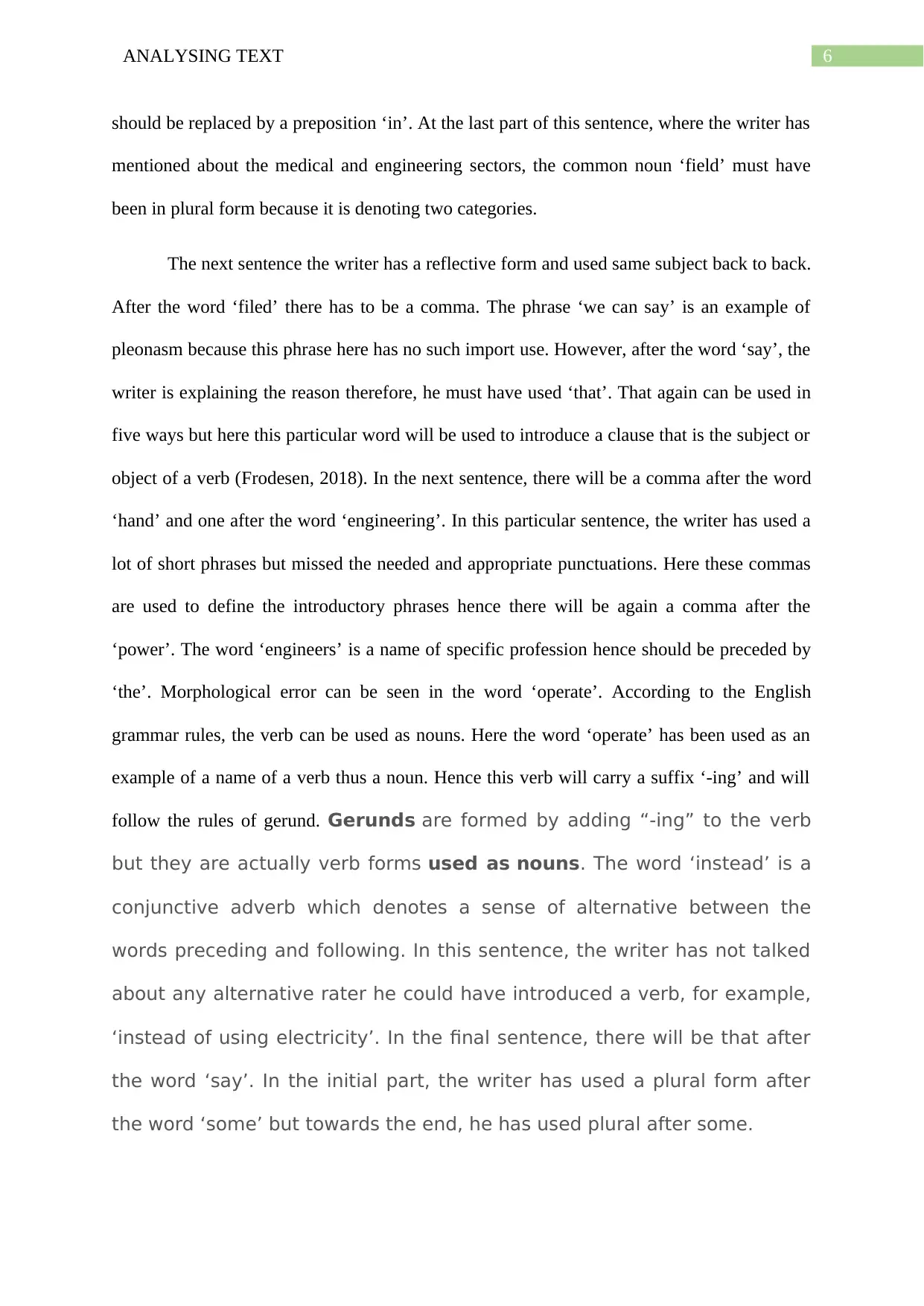
6ANALYSING TEXT
should be replaced by a preposition ‘in’. At the last part of this sentence, where the writer has
mentioned about the medical and engineering sectors, the common noun ‘field’ must have
been in plural form because it is denoting two categories.
The next sentence the writer has a reflective form and used same subject back to back.
After the word ‘filed’ there has to be a comma. The phrase ‘we can say’ is an example of
pleonasm because this phrase here has no such import use. However, after the word ‘say’, the
writer is explaining the reason therefore, he must have used ‘that’. That again can be used in
five ways but here this particular word will be used to introduce a clause that is the subject or
object of a verb (Frodesen, 2018). In the next sentence, there will be a comma after the word
‘hand’ and one after the word ‘engineering’. In this particular sentence, the writer has used a
lot of short phrases but missed the needed and appropriate punctuations. Here these commas
are used to define the introductory phrases hence there will be again a comma after the
‘power’. The word ‘engineers’ is a name of specific profession hence should be preceded by
‘the’. Morphological error can be seen in the word ‘operate’. According to the English
grammar rules, the verb can be used as nouns. Here the word ‘operate’ has been used as an
example of a name of a verb thus a noun. Hence this verb will carry a suffix ‘-ing’ and will
follow the rules of gerund. Gerunds are formed by adding “-ing” to the verb
but they are actually verb forms used as nouns. The word ‘instead’ is a
conjunctive adverb which denotes a sense of alternative between the
words preceding and following. In this sentence, the writer has not talked
about any alternative rater he could have introduced a verb, for example,
‘instead of using electricity’. In the final sentence, there will be that after
the word ‘say’. In the initial part, the writer has used a plural form after
the word ‘some’ but towards the end, he has used plural after some.
should be replaced by a preposition ‘in’. At the last part of this sentence, where the writer has
mentioned about the medical and engineering sectors, the common noun ‘field’ must have
been in plural form because it is denoting two categories.
The next sentence the writer has a reflective form and used same subject back to back.
After the word ‘filed’ there has to be a comma. The phrase ‘we can say’ is an example of
pleonasm because this phrase here has no such import use. However, after the word ‘say’, the
writer is explaining the reason therefore, he must have used ‘that’. That again can be used in
five ways but here this particular word will be used to introduce a clause that is the subject or
object of a verb (Frodesen, 2018). In the next sentence, there will be a comma after the word
‘hand’ and one after the word ‘engineering’. In this particular sentence, the writer has used a
lot of short phrases but missed the needed and appropriate punctuations. Here these commas
are used to define the introductory phrases hence there will be again a comma after the
‘power’. The word ‘engineers’ is a name of specific profession hence should be preceded by
‘the’. Morphological error can be seen in the word ‘operate’. According to the English
grammar rules, the verb can be used as nouns. Here the word ‘operate’ has been used as an
example of a name of a verb thus a noun. Hence this verb will carry a suffix ‘-ing’ and will
follow the rules of gerund. Gerunds are formed by adding “-ing” to the verb
but they are actually verb forms used as nouns. The word ‘instead’ is a
conjunctive adverb which denotes a sense of alternative between the
words preceding and following. In this sentence, the writer has not talked
about any alternative rater he could have introduced a verb, for example,
‘instead of using electricity’. In the final sentence, there will be that after
the word ‘say’. In the initial part, the writer has used a plural form after
the word ‘some’ but towards the end, he has used plural after some.
Paraphrase This Document
Need a fresh take? Get an instant paraphrase of this document with our AI Paraphraser
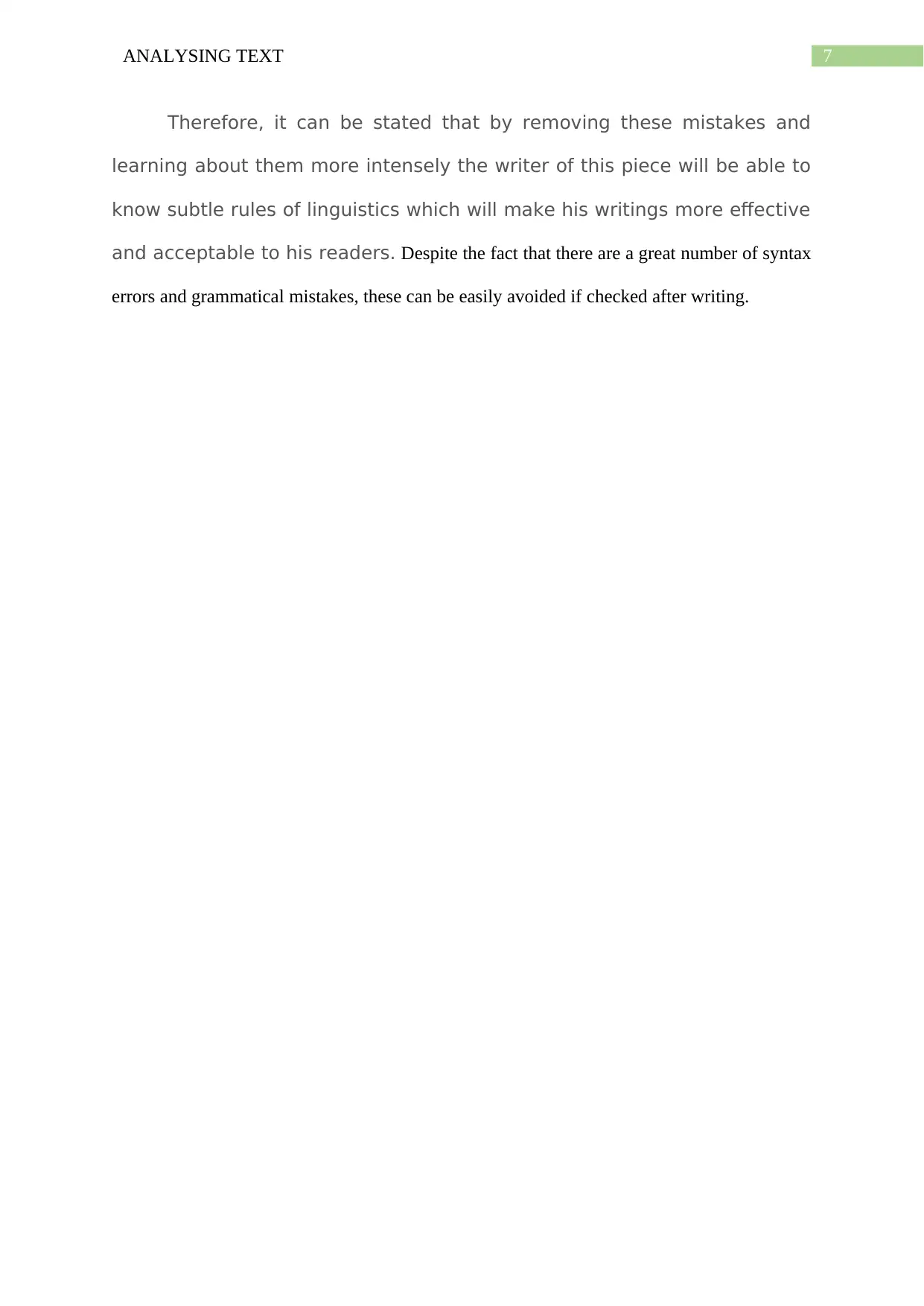
7ANALYSING TEXT
Therefore, it can be stated that by removing these mistakes and
learning about them more intensely the writer of this piece will be able to
know subtle rules of linguistics which will make his writings more effective
and acceptable to his readers. Despite the fact that there are a great number of syntax
errors and grammatical mistakes, these can be easily avoided if checked after writing.
Therefore, it can be stated that by removing these mistakes and
learning about them more intensely the writer of this piece will be able to
know subtle rules of linguistics which will make his writings more effective
and acceptable to his readers. Despite the fact that there are a great number of syntax
errors and grammatical mistakes, these can be easily avoided if checked after writing.
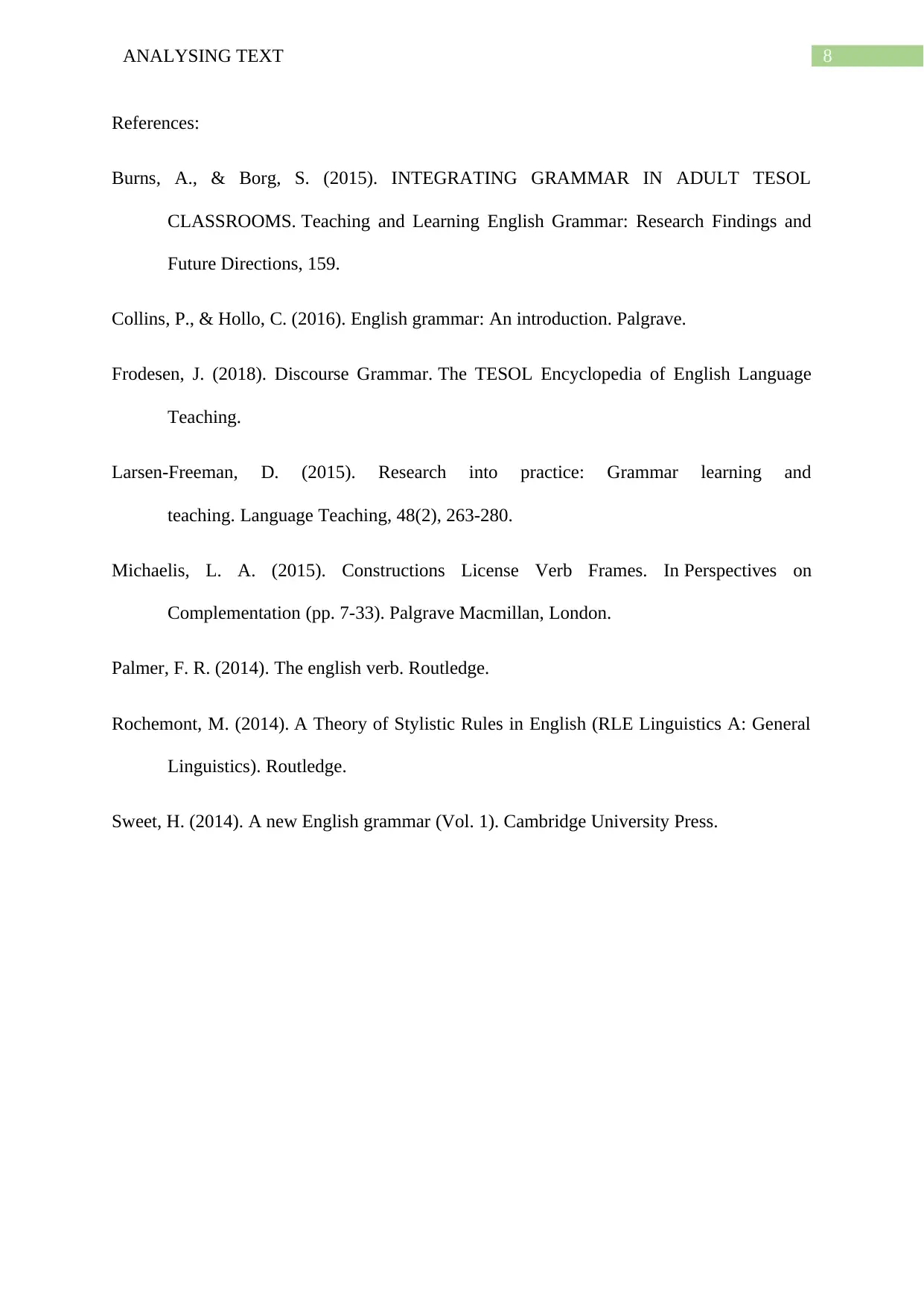
8ANALYSING TEXT
References:
Burns, A., & Borg, S. (2015). INTEGRATING GRAMMAR IN ADULT TESOL
CLASSROOMS. Teaching and Learning English Grammar: Research Findings and
Future Directions, 159.
Collins, P., & Hollo, C. (2016). English grammar: An introduction. Palgrave.
Frodesen, J. (2018). Discourse Grammar. The TESOL Encyclopedia of English Language
Teaching.
Larsen-Freeman, D. (2015). Research into practice: Grammar learning and
teaching. Language Teaching, 48(2), 263-280.
Michaelis, L. A. (2015). Constructions License Verb Frames. In Perspectives on
Complementation (pp. 7-33). Palgrave Macmillan, London.
Palmer, F. R. (2014). The english verb. Routledge.
Rochemont, M. (2014). A Theory of Stylistic Rules in English (RLE Linguistics A: General
Linguistics). Routledge.
Sweet, H. (2014). A new English grammar (Vol. 1). Cambridge University Press.
References:
Burns, A., & Borg, S. (2015). INTEGRATING GRAMMAR IN ADULT TESOL
CLASSROOMS. Teaching and Learning English Grammar: Research Findings and
Future Directions, 159.
Collins, P., & Hollo, C. (2016). English grammar: An introduction. Palgrave.
Frodesen, J. (2018). Discourse Grammar. The TESOL Encyclopedia of English Language
Teaching.
Larsen-Freeman, D. (2015). Research into practice: Grammar learning and
teaching. Language Teaching, 48(2), 263-280.
Michaelis, L. A. (2015). Constructions License Verb Frames. In Perspectives on
Complementation (pp. 7-33). Palgrave Macmillan, London.
Palmer, F. R. (2014). The english verb. Routledge.
Rochemont, M. (2014). A Theory of Stylistic Rules in English (RLE Linguistics A: General
Linguistics). Routledge.
Sweet, H. (2014). A new English grammar (Vol. 1). Cambridge University Press.
1 out of 9
Your All-in-One AI-Powered Toolkit for Academic Success.
+13062052269
info@desklib.com
Available 24*7 on WhatsApp / Email
![[object Object]](/_next/static/media/star-bottom.7253800d.svg)
Unlock your academic potential
© 2024 | Zucol Services PVT LTD | All rights reserved.

